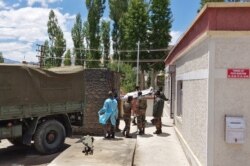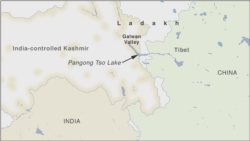The deadliest confrontation between India and China in nearly five decades that killed 20 Indian soldiers represents a dangerous escalation of their long-simmering border dispute and the path to a resolution will not be easy for two countries led by nationalist leaders, say analysts.
“I would like to assure the nation that the sacrifice of our jawans (soldiers) will not be in vain,” Prime Minister Narendra Modi said in televised remarks in New Delhi on Wednesday. “For us, the unity and sovereignty of the country is the most important. India wants peace but when provoked is capable of giving a befitting reply be it any kind of situation.”
Both sides have blamed each other for provoking the violent faceoff in an icy, barren Himalayan desert in the Galwan Valley in Eastern Ladakh. Details remain sketchy – but the troops are reported to have fought with iron rods and rocks during a prolonged brawl. According to reports in Indian media, some soldiers fell or were pushed into a river.
While Indian officials say the Chinese army also suffered losses, Beijing has not confirmed it.
“The killing of Indian troops by very barbaric means has pushed the Indian government into a corner. It has to react in a fairly meaningful fashion if it is not to lose the public support it has,” said Bharat Karnad, a strategic affairs expert at the Center for Policy Research in New Delhi, who warns that the dispute could escalate.
In Beijing, Foreign Ministry spokesman Zhao Lijian said that China does not want to see any more clashes on the border with India and both sides are in close communication on resolving the situation through diplomatic and military channels.
The violence took many in India by surprise – it came two days after India’s army chief, Manoj Naravane, confirmed that both armies were “disengaging” from the Galwan Valley in eastern Ladakh following “fruitful” talks to defuse recent border tensions.
The Asian rivals had deployed thousands of additional troops and heavy artillery in recent weeks as tensions flared following accusations by India that Chinese soldiers had intruded into its side of what is known as the Line of Actual Control. The points of contention included the Galwan Valley. China has denied altering the status quo.
While the Indian army has said that troops from both sides have disengaged from the site of the clash, lowering heightened tensions poses a huge challenge for the Asian giants.
“It is pretty dangerous,” says Manoj Joshi, a foreign policy analyst at the Observer Research Foundation in New Delhi. “Just the scale of casualties makes it difficult and complicated to defuse.”
The violence that erupted this week is the most serious in decades between the two countries that have not resolved their competing claims to several stretches of their 3,488-kilometer border in the Himalayas, since they fought a brief war in 1962.
While scuffles, fistfights and shouting matches occur occasionally between border patrols due to what officials say are differing perceptions of the Line of Actual Control, there have been no incidents of firing or casualties in border skirmishes since 1975.
The latest incident however marks a huge departure from the past.
Analysts say the path to defusing the crisis will be especially challenging because a muscular foreign policy has been the hallmark of both Indian Prime Minister Modi and Chinese President Xi Jingping.
"This will likely be a watershed moment in India-China relations and the geopolitics of the Indo-Pacific,” according to Abraham Denmark, Asia Program Director at The Wilson Center in Washington. “Both countries are led by men who have embraced nationalism, and both countries are facing tremendous domestic and international upheaval as a result of COVID-19 and other long-standing problems.”
Even if the two countries manage to put a lid on the immediate crisis, the recent border disputes that have erupted will continue to be a flashpoint as both sides appear to have taken entrenched positions leaving little room for compromise.
India in particular is in no mood to accept what it says are Chinese claims on the Galwan Valley.
“Anything short of the Chinese vacating the Galwan Valley will be unacceptable to India and that withdrawal the Chinese are not willing to do because they now claim this is the new Line of Actual Control in effect,” according to security expert Karnad.
At the same time, India is also unprepared for any escalation at a time when it is battling the spiraling coronavirus pandemic and a bruised economy. While the crisis may not be resolved anytime soon, analyst Joshi said “It does not suit either of their interests to allow this to go beyond a certain point.”









